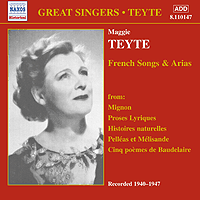| Great Singers: Maggie Teyte
(1888-1976)
French songs and Arias
|
 |
Accompaniments |
|
Crotchet AmazonUK AmazonUS Amazon recommendationsHere is a CD to add to your collection. It's title gives the plain fact: Maggie Teyte was a great singer. This CD is cogent evidence of that and can be enjoyed at any level. The connoisseur will add it to his collection probably to complement the Pearl Maggie Teyte Mélodies. The novice, who may not be familiar with her work should start here…..and now.
There can be no better introduction to her singing than the first track: Mignon's Connais-tu le pays? That gloriously mellow voice positively drips from the disc. In the lower register one almost quivers with pleasure at the depth of the sound. And that is not all. On this track the consummate conductor in such delicate work is Pierre Monteux with the San Francisco Symphony Orchestra.
Move onto track two and the first example of Duparc's L'invitation au voyage. I did not think that this track, recorded in 1947, compared well with track 17, the same work recorded in 1940. The latter was infinitely more atmospheric and one could hear the translucent quality of the higher ranges hovering in the air. The Utopian concept radiates.
Enjoy the two brief Ravel songs accompanied by Gerald Moore. No more can be said of the brilliance of his accompaniments and these, and other tracks, are further examples of this distinctive artistry.
I will not mention every track but would do the disc less than justice if I did not single out L'Adieu from Act III of Hahn's Mozart. For me this is a superb example of her perfected ability. Buy this disc for this track alone.
I pass quickly over the two songs of Chausson pausing to regret that I never heard her "live" and move onto the five Debussy tracks. The first two are from Pélleas et Mélisande. She had the enormous advantage of studying the role of Mélisande with Debussy and later being accompanied by him in recitals of his music. It is hardly surprising that Debussy is reported as saying that she was Mélisande.
I find it intriguing to consider that this enormously strong French influence (born Maggie Tate but changed to Teyte to accommodate the French) followed grounding in other composers particularly Mozart, Puccini and Verdi. One of her formative teachers was Jean de Reszke who could trace teaching skills back to the bel canto teachers including Pauline Viardot. Thus it was that her first public performance was singing Cherubino's arias from Mozart's Le Nozze di Figaro.
And, joy of joys. The wheel comes full circle because the final track, described so accurately as a "Bonus Track", is the 1947 recording of Voi che sapete recorded on the same date as Connais-tu le pays? and also accompanied by Pierre Monteux. It is unfair to compare this recording with modern recordings but only because the technical wizardry of modern recordings was not then available. How meaningful she makes this aria. How full of questioning youthful enthusiasm and full of colourful contrasts - and recorded when she was 58.
So go and spend £4.99 on this historical recording. Marvel at what Naxos has achieved. If the last piece you listened to was a modern hiss-less recording then you will notice the background hiss… Initially…. But soon after, that will disappear as you are wrapped in the sound of one of the greatest exponents of French songs with the ultimate in accompanists.
Robert McKechnie